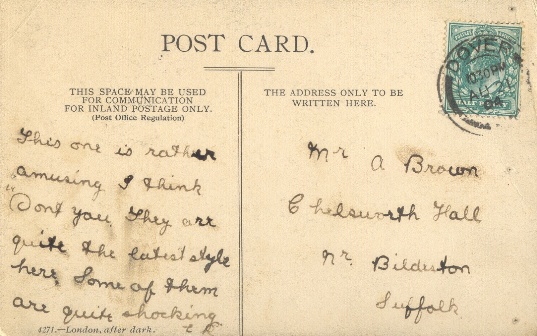Source: Report from Police Sergeant George Jordan, Arbour Square station, H Division, The National Archives, MEPO 2/9172 file 590446/5, ‘Bioscope & Cinematograph Shows’, March 11th, 1909
Text: No 12 High Street, Whitechapel has been recently erected. The front has been constructed with a pay box in the centre and a pair of doors each side.
The price of admission is: – Adults 2, Children 1 penny.
The room is about 45 ft deep and 20 ft wide. The machine and films are placed in a fireproof box just inside the entrance and immediately behind the paybox. The sheet on which the pictures are shown being at the far end. The machine is worked by one of the three adult attendants who relieve each other.
There are several rows of “tip-up” seats near the curtain, with ordinary chairs behind occupying two-thirds of the floor space; the remaining portion being for standing room only.
A five foot gangway is arranged at one side of the seats, with an exit door opening outwards half-way down. An electric piano placed near the screen plays continuously. About 250 English and Jewish people were present, including about 100 children.
No 63 Whitechapel Road was formerly a small shop; it has only one ordinary door opening into a room 30 feet deep by 15 feet wide.
Adults are charged one penny and children one halfpenny for admission.
The machine and films are placed in an asbestos box at the far end of the room and worked by an adult operator employed for that purpose. The pictures are shown on a screen attached to the window.
Chairs are provided in rows with a four foot passage way at the side. There was a mixed audience of about 100 persons present, half of whom were children.
An ordinary piano was placed near the window with a notice displayed inviting members of the audience to play; a young girl was playing when I entered. The proprietor’s wife, son age about 20, and a boy were acting as attendants.
No 97 Commercial Road was formerly a small shop with window and side door leading to a passage and to the room in question, which is about 30 feet deep and 15 feet wide.
Adults pay one penny; children one halfpenny for admission.
Forms are placed across the room rising in height at the back to about four feet. There is one central passage between the forms not more than three feet wide.
The audience numbered about 150; about 100 being children from four years upwards; the remainder were young Jews – male and female.
The machine and films are placed in a separate room at the rear. This room is about six feet above the shop level, with a rough “Jacobs” ladder leading to it from the side passage. The machine stands on an iron base about 12 inches above the wooden floor. It has no protecting box and there is a bedstead and table near.
An adult operator is employed at 30/- per week.
A hole has been made in the parting wall and the pictures are exhibited on a screen attached to the shop window …
In all these places of entertainment the audience is mixed together irrespective of age or sex. A series of five or six sets of pictures are shown in quick succession lasting from 30 to 45 minutes. During that time the room is in darkness. The rays from the lantern slightly illuminate the benches near the curtain, but at the opposite end where some of the spectators stand up in order to get a better view, it would be quite easy for acts of misconduct or indecency to take place without fear of detection.
In several cases the only means of exit is by one door, and the gangways are so narrow and inadequate that if an alarm of fire was raised it would be impossible for the younger members of the audience to escape in the rush that would ensue, and there might be loss of life.
Comments: This police report is part of a series of reports from the various Metropolitan Police Divisions conducted in March 1909, driven by concerns of crime, indecency and fire hazards in the small shop-conversions cinemas, or bioscopes, that existed in London at this time. The report covers the Whitechapel district of East London. The Whitechapel Picture Theatre was located as 12 Whitechapel Street and was managed by Charles Robinson. The name of the entertainment at 63 Whitechapel Road is not known but the proprietor was Barnard Cohen. Happy Land was located at 97 Commercial Road, run by Lewis Klein.
Links: National Archives file reference

